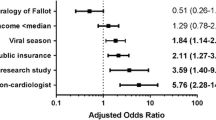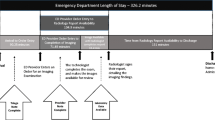Abstract
Background
An appropriate clinical history improves the perception and interpretation of radiographic examinations in children and adults. However, clinical history provided on radiology request has not been studied for its appropriateness and frequency of cloned clinical history.
Objective
The purpose of this study was to determine the frequency of inappropriate histories and cloned histories at a tertiary-care children’s hospital.
Materials and methods
We analyzed radiology request forms of 388 outpatient and inpatient radiographic examinations obtained on 3 days during the same month at a tertiary-care children’s hospital. Appropriateness of the clinical history was judged by its relevance to the examination ordered and appropriate associated billable ICD-9 code. Cloning was defined as identical clinical histories appearing on the radiology request on three consecutive days. Cloned histories were further subdivided as being appropriate or inappropriate.
Results
A total of 18% (70/388) of the requests for clinical history were either inappropriate, cloned or both. Neonatal intensive care unit (NICU) referrals constituted the majority (82%, 9/11) of combined inappropriate history and cloning. NICU referrals accounted for 52% (28/54) of all inappropriate clinical histories, a significantly higher percentage than other inpatient locations (P = 0.006). The cardiovascular intensive care unit (CVICU) was the second most common patient location for inappropriate clinical histories (11%, 6/54). About one-third of the radiographic requests from the NICU had inappropriate histories (35%, 28/79). Among the outpatient referrals, 50% (4/8) of the inappropriate histories were from the emergency department. The most common cloned histories included “hypoplastic left heart syndrome” (15%, 4/27), “endotracheal tube placement” (11%, 3/27) and “evaluate lung fields and bowel” (11%, 3/27). The most commonly cloned clinical history was seen on referrals from the NICU at 63% (17/27), a significantly higher percentage than other inpatient locations (P = 0.006). The CVICU unit accounted for the second most common patient location for cloned clinical histories (26%, 7/27). The cloned clinical history on the referral request for radiography was unjustified in 48% (13/27) of the cases. NICU referrals had 85% (11/13) of the unjustified cloned histories.
Conclusion
Inpatient units, particularly the NICU, were most likely to have inappropriate histories and cloning. Cloning was clinically justified in about half of the cases of cloning. The patterns of inappropriate histories and cloning suggest possible corrective measures.



Similar content being viewed by others
References
Berbaum KS, Franken EA, Dorfman DD et al (1994) Influence of clinical history on perception of abnormalities in pediatric radiographs. Acad Radiol 1:217–223
Loy CT, Irwig L (2004) Accuracy of diagnostic tests read with and without clinical information: a systematic review. JAMA 292:1602–1609
Agarwal R, Bleshman MH, Langlotz CP (2009) Comparison of two methods to transmit clinical history information from referring providers to radiologists. J Am Coll Radiol 6:795–799
American College of Radiology (2012) ACR-SPR practice guideline for general radiography. http://www.acr.org/∼/media/95AB63131AD64CC6BB54BFE008DBA30C.pdf Accessed 11 August 2012
Teunen D (1998) The European directive on health protection of individuals against the dangers of ionising radiation in relation to medical exposures (97/43/EURATOM). J Radiol Prot 18:133–137
Triantopoulou C, Tsalafoutas I, Maniatis P et al (2005) Analysis of radiological examination request forms in conjunction with justification of X-ray exposures. Eur J Radiol 53:306–311
Palmetto GBA Medicare (2011) Jurisdiction 11 Part B, Medical Record Cloning. Available via http://www.palmettogba.com/palmetto/providers.nsf/DocsCat/Providers∼Jurisdiction%2011%20Part%20B∼CERT∼General%20Information∼8MKQK88358?open&navmenu=CERT%7C%7C%7C%7C. Accessed 23 January 2013
Price MB, Grant MJ, Welkie K (1999) Financial impact of elimination of routine chest radiographs in a pediatric intensive care unit. Crit Care Med 27:1588–1593
Oba Y, Zaza T (2010) Abandoning daily routine chest radiography in the intensive care unit: meta-analysis. Radiology 255:386–395
Quasney MW, Goodman DM, Billow M et al (2001) Routine chest radiographs in pediatric intensive care units. Pediatrics 107:241–248
Conflict of interest
None.
Author information
Authors and Affiliations
Corresponding author
Rights and permissions
About this article
Cite this article
Shah, C.C., Linam, L. & Greenberg, S.B. Inappropriate and cloned clinical histories on radiology request forms for sick children. Pediatr Radiol 43, 1267–1272 (2013). https://doi.org/10.1007/s00247-013-2648-7
Received:
Revised:
Accepted:
Published:
Issue Date:
DOI: https://doi.org/10.1007/s00247-013-2648-7




